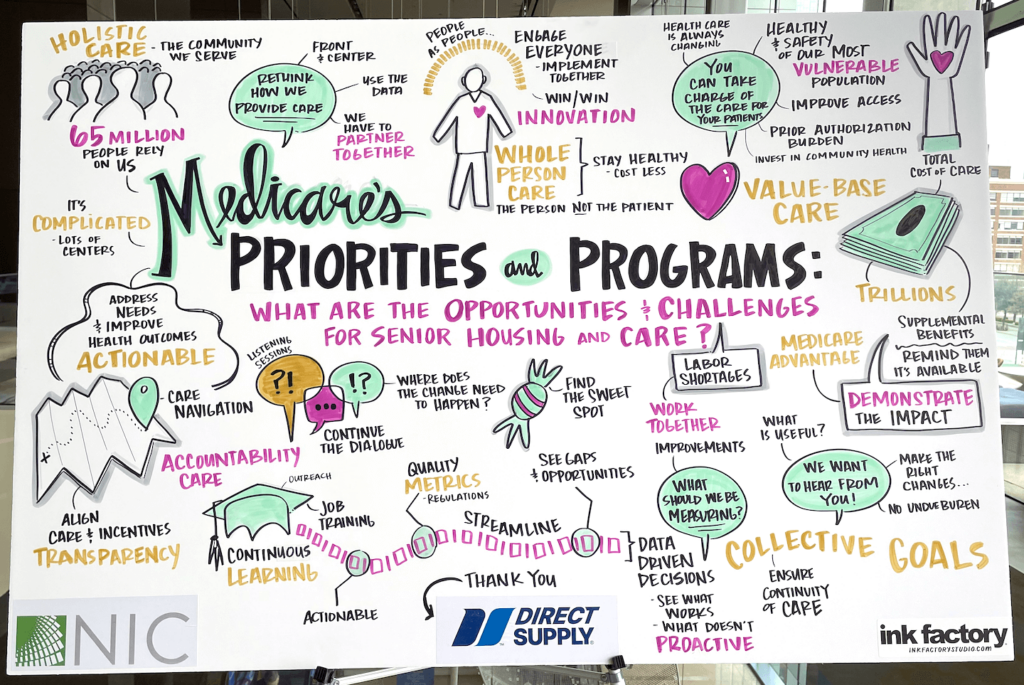
DALLAS — Even though senior living providers, by law, are unable to directly bill the Medicare program for the services they provide to residents, they are able to partner with other organizations focused on value-based care, to help improve residents’ quality of life and save the healthcare system money. And senior living companies can be part of solutions to improve care provision in part by offering feedback to the federal government.
Those were some of the thoughts that Meena Seshamani, MD, PhD, deputy administrator and director of the Center for Medicare at the Centers for Medicare & Medicaid Services, shared with attendees at Wednesday’s keynote session of the National Investment Center for Seniors Housing & Care’s 2024 Spring Conference. Seshamani was interviewed on stage by David C. Grabowski, PhD, professor of healthcare policy at Harvard Medical School.
“We all have to partner together to figure out how we can provide better care, improve the health of our populations and be able to spend the healthcare dollar in a more effective way,” Seshamani said.
There “absolutely” is an opportunity for senior living providers to bring care and services to residents on-site to help them avoid the emergency department visits and hospital transfers that can be costly for individuals and the health system, she said. That opportunity can come via data-driven partnerships with entities such as accountable care organizations in the Medicare fee-for-service program or with Medicare Advantage plans outside of the traditional Medicare program.
“Those partnerships enable some of what everybody, all of us together, seek to provide,” Seshamani said.
“In fee-for-service Medicare, where we have these accountable care organizations, there are opportunities to partner with these providers to demonstrate, ‘Hey, here is a way that you can provide better care to your communities, keep them healthy. You’ll improve your quality metrics and you’ll save money,’ and the provider shares in those savings,” she said. “On the Medicare Advantage side, this is where we want to get more information on what kinds of benefits or kinds of work [are] working, and how. So I think this is a huge opportunity for us to engage to get more data and transparency and analytics.”
Data, Seshamani said, will help the agency “understand what is being tried and how is it working, because then we can take that in, in our program, to be able to say, ‘OK, how can we, within the authorities that we have in the Medicare program, try to leverage that so that we can make sure that this program is working the best that it can for the people that it serves?’”
Senior living providers can provide input on “where there are opportunities that Medicare can ‘put its shoulder to the wheel’ to really improve care,” she added.
One way is by answering a request for comment about data collection and transparency within the Medicare Advantage program, which the agency is seeking by May 29, Seshamani said.
In fact, opportunities exist for senior living providers to contribute input on any proposed CMS regulation, she said.
“Anytime we put out a regulation, it is proposed, and we take in comments to incorporate when we finalize,” Seshamani said. “So that is another good way to provide feedback.”
A third way to participate is via a listening session, which she said CMS hosts regularly.
“The Medicare program is almost a trillion dollars a year, so we cannot take decisions lightly, because we are talking about the health, safety and well-being of some of our most vulnerable populations, and we are talking about billions and trillions of dollars, potentially,” Seshamani said. “So it is extremely important for us to be able to use data transparency, encourage innovation towards our collective goals and encourage market competition to compete in the ways that we want. That is all very central to our mission.”
Noting that skilled nursing providers are “very far along the path” of collecting data but senior living providers are not, Grabowski asked Seshamani which data she thought were important for senior living providers to collect in terms of quality metrics. She pointed to a New England Journal of Medicine article that she and some of her colleagues had written, proposing a streamlined “universal foundation” of quality measures to reduce the reporting burden and confusion for providers and better align measures across the agency’s more than 20 quality programs. The topic, she said, brought up a “call to action” for senior living providers.
“As you are forging partnerships, as you are thinking about different ways to care for our communities, what are the things that we should be measuring? What are the things that you want to be held accountable to? …Help us to think about what the next round of metrics should be so that we can continue to engage in this continuous learning together,” Seshamani said.
Bob Kramer, NIC co-founder and senior adviser, introduced the session, facilitated by question-and-answer period and concluded the session.
“We have an enormous opportunity as a sector, because we have our eyes 24/7, basically, on Medicare beneficiaries, and we have our eyes 24/7 on the folks that are the 51% that are now in MA plans and the many that are in ACO REACH [Realizing Equity, Access, and Community Health] plans. So we have an opportunity to be collecting data,” Kramer said. “If I had to underline one thing about our interaction as a sector now that we, so to speak, have moved from side stage to main stage in terms of the nation’s health, particularly as it regards the healthcare costs and the quality of life for older adults, it’s that we’ve got to provide data. We just can’t say, ‘We do a great job. We make such a difference. Senior living is wonderful.’ It’s about the data. And Dr. Seshamani’s appearance here, and she’s basically opened the door and said, ‘OK, give us your data. Show us your results.”
The 2024 NIC Spring Conference began Tuesday and ends today.


